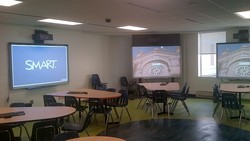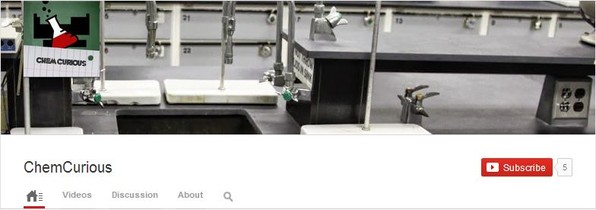Integrating Active Videos into Active Learning
Dawson’s second active learning classroom became operational last week. Active learning classrooms have created some interesting challenges. Students sit in groups of six or seven and don’t need to face you because the rooms contain eight Smartboards of which only two are for the teacher. You can project your PowerPoint or your Smartnotes and students can look at those or they can look at you. Whatever the case, we’re trying to have more active learning situations that take advantage of this new environment. I prepare problems for the class to solve so they’re more active. After this short burst of activity, I can go back to teaching for ten minutes, trying to keep learners involved through participation in a variety of activities.

Dawson’s New Active Learning Classroom in the final stages of construction
The Challenge
On a personal note, I’m friends with Christian Viel, the cinematographer. Although he’s a movie director, he has a bachelors in chemistry. I saw that SALTISE was offering a mini-grant of $1800, and I convinced him to help me in a project to make videos for my classes. We initially wanted to make crazy magic videos where you light something up, and it explodes, or a balloon catches on fire. I know there are a lot of those videos online right now, but many of them are recorded with a phone device. There’s lots of background noise and often a lot of swearing. Things are not explained. We wanted to make clips under five minutes long that would explain a chemical phenomenon with good camerawork and lighting.
Our project was accepted, but SALTISE asked for more course oriented material. We adapted our project to General Chemistry. We’ve taken on a lot of serious topics in chemistry such as heat exchange, acid based reaction and colour change precipitation in a manner that’s visually engaging.
The Inspiration
Furthermore, we wanted to make the videos more interactive to reach out to active learners by providing decisions to make. We got this idea from a YouTube video made by Patrick Boivin with characters from Street Fighter. The viewer could touch a character on the screen and he would give a punch. What would really happen was the viewer would be switched to another video where the character would give a punch. Clicking again would replay the punch relooping the same video, or if you clicked on the kick, it would switch to the kick video. The viewer has the impression of control, but the author has videotaped all the options.
We wanted to film experiments that would have at least two different outcomes so that students could click on a given outcome and switch to another video which would give you that result, answer or conclusion.

Chem Curious YouTube channel, project of Yann Brouillette
The Results
Our first attempt used Coca-Cola cans in a big jar of water. Students could see which cans would float or not depending on the sugar content. After that, we decided we would make ten videos and ended up making twelve. Some are very exciting, but some aren’t. We decided that it was nice to always have a cool impact, a cool solution where something explodes, sinks or precipitates, becoming red, yellow or white. But, once you start telling chemistry students about reactions, they think that everything reacts all the time. It’s good to go back to the basics and say, No, some things don’t react and that’s why we’re able to hold on to a glass and drink water, and water will not dissolve your glass.
And so, we planned reactions where one of the outcomes would give you nothing, and one of the outcomes would produce a reaction. The videos might not all be entertaining for the general public because some of the outcomes are rather boring, but they are educational in that students realize not everything reacts with a bang.
Video introducing density with soda cans which have different sugar content
I’m able to project a link to every group in the active learning classroom. Student groups will choose the different outcomes together. At times these choices will serve as an introduction to a subject. For example, the video with the soda cans introduces density. Other videos will be played at the end of a topic. Another advantage is that if I don’t have time to show a video in class, I can give students the link on LEA so that they can see them at home.
There are three videos about precipitation reactions. Aqueous solutions that are transparent liquids that when mixed together sometimes produce a solid precipitate of certain colours but sometimes don’t. There are many rules about this – one element doesn’t create a precipitate – another one does – and after a while students lose focus. Cutting the lesson in half with a video and then going back to the rules makes the information more dynamic, more fun and gives learners a visual image to remember before they begin experimenting in the lab.
The Next Step
I look at these videos as the cool solution in the reaction between my interests in chemistry, film and active learning. As these films have been posted on YouTube, I would like to extend an invitation to Profweb’s readers to use them in the classroom or as a model for other productions. Have you developed material specifically for use in an active learning classroom?

